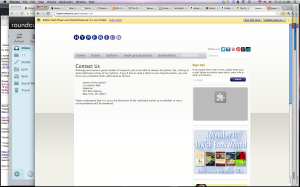Thursday was full of extremes, with both positive and negative encounters.
On the positive side, I had two amazing one-to-one meetings: with the former mayor of a nearby town who just took a job with a green energy company, and then a few minutes later, with a life coach friend of mine. With both, we each brainstormed marketing ideas and helpful contacts for the other.
Then, a brief call with my own coach, Oshana Himot, who continues to amaze me with her sheer brilliance. My business is engaged in a major shift toward much deeper work, and she can take much of the credit. And finally, a Chamber mixer where I managed to have several substantive conversations. I was introduced to a gentleman I didn’t know who’s partnering with an organic farmer friend of mine to make tortillas using local corn. As a local food advocate, marketer, and foodie, I’m eager to help him succeed. Then was my friend who runs the local TV station, on his capital campaign and new building they’re going to construct. I offered him a resource about building deeply green, and he, out of the blue, offered to shoot a promo for me. And finally, a woman in my own town who will bring a much-needed progressive and articulate voice to the Selectboard.
But on the same day, I had three encounters with enormous stupidity.
1. We’d been contacted by a charity some time back to see if we had any goods to donate. We did indeed, and in the intervening two weeks, we’ve filled three large boxes with books and a huge trash bag of clothes. Originally, we were going to put all this in front of the garage for pickup, so we wouldn’t have to wait around. They’re not allowed to actually open the door. But since that was set up, it’s snowed several times and our garage is completely blocked off. So I called to explain that the crew would have to ring our bell, since we couldn’t put things out by the garage and we didn’t want to ruin it all by putting it right in the snow. And then I asked for a two-hour window for the pickup, so we could be sure to be here. No can do, she told me; they’ll be there any time between 8 a.m. and 6 p.m. I told her that I wasn’t going to be stuck in my house all Saturday waiting for them. Finally, after about ten minutes of back and forth, she gave me a phone number to call Saturday morning where they’d be able to narrow it down at least a little. Not exactly customer service heroism—especially considering WE’re doing THEM a favor by donating goods.
2. Between my two morning meetings, I had to walk in a busy, narrow street in the central business district of a nearby village, because one gas station owner hadn’t shoveled his side walk. I poked my head in the office and mentioned the problem. The owner growled, “It hasn’t been 24 hours.” Yet every other property owner had managed to clear the sidewalk, Guess where I’m never buying gas again as long as I live (and yes, I have been a customer there, in the past).
3. My wife and I were the only customers in a restaurant except for one person picking up a takeout order, for about 40 minutes. Just as we were about to leave, a woman showed up prepared to make a large takeout order. It was 10 minutes to 8 and they sent her away, saying they were closed. It probably would have delayed their 8 pm closing by 10 or 15 minutes and more than doubled their take for the hour. (The owner was not present). And it would have kept that customer coming back.
In all three cases, all I could do was scratch my head in amazement. I will not beat you over the head with the obvious customer service lessons from these three encounters with stupidity. Unlike the three perpetrators, you’re smart enough to figure it out.





